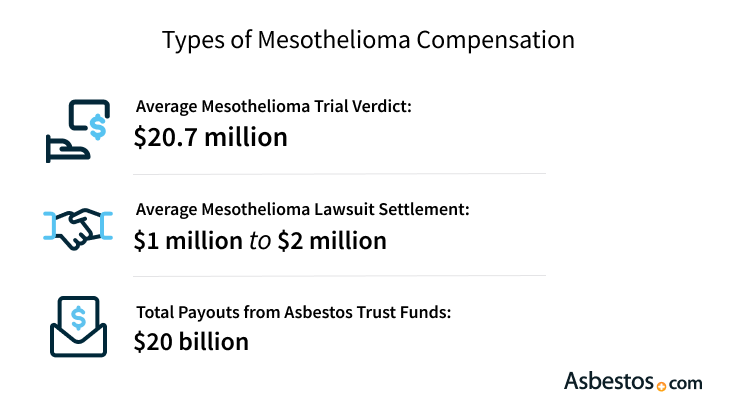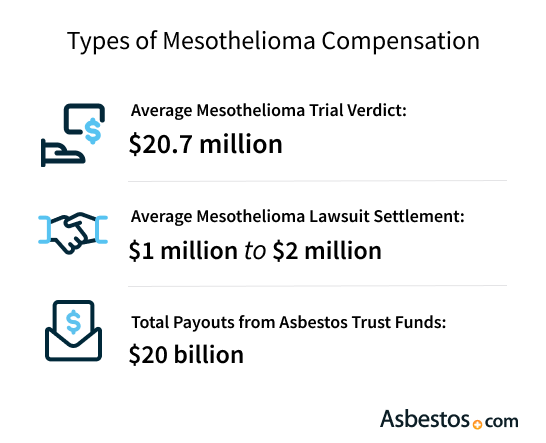Mesothelioma Statistics
Written by Sean Marchese, MS, RN | Edited By Amy Edel | Medically Reviewed By Dr. Jacques Fontaine
How Common Is Mesothelioma?
Mesothelioma is a rare cancer. It accounts for less than 0.2% of all cancer diagnoses in the U.S. Every year fewer than 3,000 new mesothelioma cases are diagnosed in the U.S, according to data from the Centers for Disease Control and Prevention and National Cancer Institute’s U.S. Cancer Statistics Working Group. There were 2,803 new mesothelioma cases reported in the U.S. in 2021, the latest year of available data.
Doctors diagnosed 72,779 new cases of mesothelioma cancer in the U.S. from 1999 to 2021. Since 1999, the highest number of new mesothelioma cases reported in the U.S. occurred in 2011, with 3,376 diagnoses. While cases were trending down in 2020 and 2021, the COVID-19 pandemic may have delayed diagnoses during this time period.
The most recent federal mesothelioma data is from 2021 because it takes time to gather, carefully assess and report accurate information from participants in the National Program of Cancer Registries and the National Cancer Institute’s Surveillance, Epidemiology and End Results Program. This detailed and extensive national process is why there’s often a delay before newer numbers are available.
Peritoneal mesothelioma survivor and advocate Tamron Little understands just how rare this cancer is. She tells us, “Mesothelioma is a very rare cancer. The first oncologist I saw was honest and said he didn’t know anything about peritoneal mesothelioma. After that visit, I was determined to find a mesothelioma specialist.”
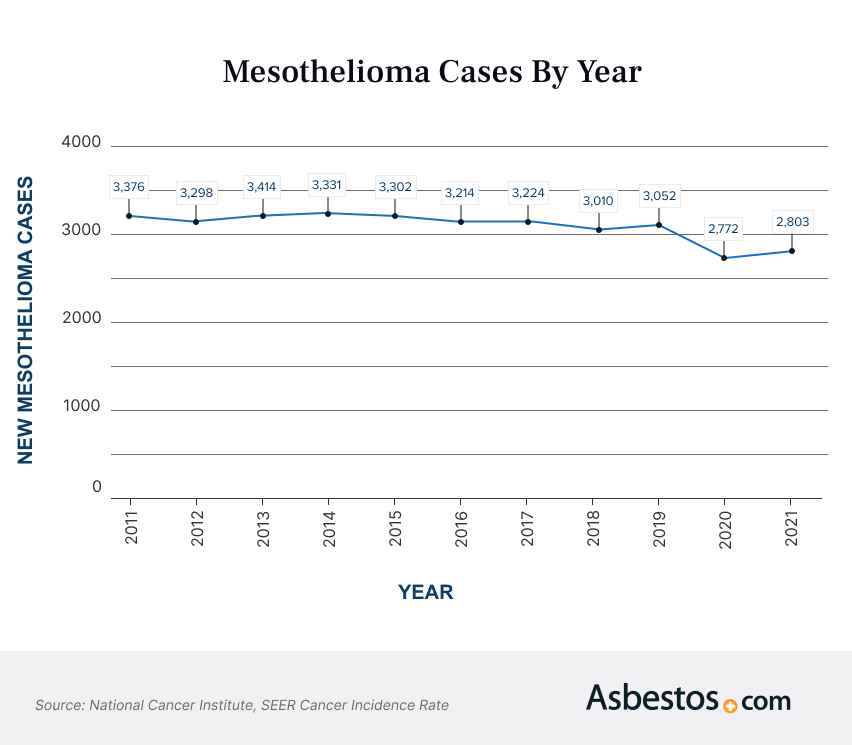
Mesothelioma Statistics Across the US
Mesothelioma incidence rates in each state across the U.S. vary. Areas with a strong history of industrial work and manufacturing have higher rates of asbestos-related diseases. California reported 284 new cases, Florida reported 237, and Texas reported 206 in 2021.
States with naturally occurring asbestos deposits, including Washington and Pennsylvania, also have high mesothelioma rates. U.S. Cancer Statistics Working Group data from 2021 shows the mesothelioma incidence rate in Washington state was 0.9 per 100,000 people. The mesothelioma incidence rate in Pennsylvania was 0.8 per 100,000 people in 2021.
Highest Rates Per 100K People
- Idaho: The total new case count was 21 and the state population in 2021 was 1,904,314. The age-adjusted rate of new mesothelioma cases in 2021 in these states was 0.9 in 100,000 people.
- Minnesota: The total new case count was 69 and the population of the state in 2021 was 5,711,471. The age-adjusted rate of new mesothelioma cases in 2021 in these states was 1.0 in 100,000 people.
- New Hampshire: The total new case count was 21 and the state population in 2021 was 1,387,505. The age-adjusted rate of new mesothelioma cases in 2021 in these states was 1.0 in 100,000 people.
- New Jersey: The total new case count was 114 and the state population in 2021 was 9,267,961. The age-adjusted rate of new mesothelioma cases in 2021 in these states was 1.0 in 100,000 people.
California, Pennsylvania, Texas, New York and Ohio had the highest mesothelioma-related mortalities between 2016 and 2021. Delaware’s mortality rate from 2018-2021 was 1 per 100,000 people. Maine’s was 1 per 100,000. Alaska’s was 1.2 per 100,000. Puerto Rico had a mortality rate of 0.1 per 100,000. Georgia had a mortality rate of 0.4 per 100,000.
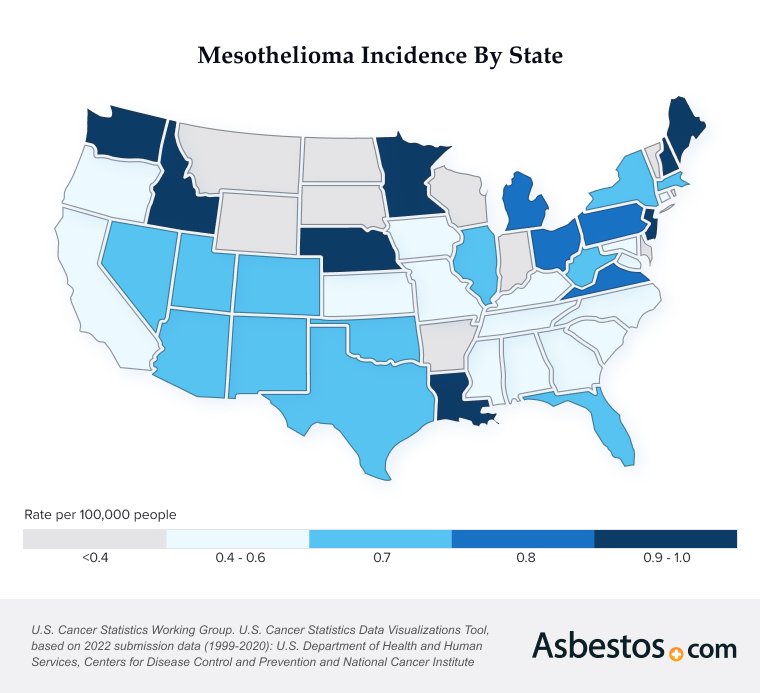

Connect with trusted specialists who truly care about your health. Get fast, stress-free appointment help.
Find a Doctor NowWho Gets Mesothelioma?
The No. 1 cause of mesothelioma is occupational exposure to asbestos. Men over 65 who worked in industries that heavily used the toxic mineral have had the highest mesothelioma incidence. The military, construction, firefighting, and manufacturing sectors have the highest mesothelioma risks.
Researchers from the Respiratory Health Division, National Institute for Occupational Safety and Health, the University of Pittsburgh and Indiana University published a study in Environmental Research in 2023. The study maps occupations, industries and mesothelioma from 2006-2022.
Mesothelioma Cases by Occupation From 2006-2022
- Manufacturing 30.1%: Includes foundry workers, welders, auto plant workers, shipbuilders and chemical plant workers.
- Construction 18.5%: Includes insulation workers, carpenters, pipefitters, roofers and brick masons.
- Educational services 8.8%: Includes teachers, custodians, maintenance staff and administrators.
- Health care and social assistance 8.7%: Includes nurses, doctors, health technicians, hospital staff, janitors and maintenance staff.
- Professional, scientific and technical 8.6%: Includes engineers, architects, consultants and lab technicians.
- Military 7.9%: Includes Shipyard workers, boiler technicians, mechanics, Naval ship and submarine personnel.
- Public administration 7.9%: Includes police officers, emergency responders and corrections officers.
- Other services 7.9%: Includes auto mechanics, HVAC technicians and small engine repair technicians.
- Transportation and warehousing 7.1%: Includes truck drivers, shipyard and dock workers, train operators and vehicle maintenance crews.
- Retail trade 6.4%: Includes auto parts dealers and clerks, as well as store workers.
Family members of workers exposed to asbestos can develop it from secondary exposure. Secondary exposure is the most common way women are exposed to asbestos, affecting about 44% of women compared to 3% of men.
The highest incidence rates occur in regions with histories of industrial and asbestos-heavy industries. Mesothelioma incidence rates describe the risk of developing this cancer.
Mesothelioma Statistics by Tumor Location
Where tumors first develop affects mesothelioma statistics. The incidence rate of pleural mesothelioma is significantly higher than for any other type. About 80% of cases occur in the pleura, the smooth tissue surrounding the lungs.
About 20% of cases are peritoneal mesothelioma. This occurs when tumors appear in the peritoneum, the smooth lining of the abdomen. About 1% are pericardial cases. This mesothelioma type forms in the heart’s lining, the pericardium. Fewer than 1% of mesothelioma cases are testicular. Tumors of this type occur in the tunica vaginalis, the lining covering of the testes.
Tumor location also affects survival rates. About 73% of patients with pleural mesothelioma survive 1 year. The 5-year survival rate is 12%. For peritoneal mesothelioma, 92% survive 1 year. The 5-year survival rate is 65%. For pericardial mesothelioma, 26% survive 1 year. The 5-year survival rate is 9%.

Mesothelioma Treatment Statistics
Treatment has a significant impact on life expectancy for patients. Mesothelioma treatment may involve surgery, immunotherapy. chemotherapy or radiation therapy. Important advances in mesothelioma treatment are improving survival for patients.
A recent study presented at the European Lung Cancer Congress looked at combining 2 or more mesothelioma treatment options, known as a multimodal approach. It showed a 1-year survival rate of 79.6% for pleural mesothelioma patients who underwent a combination of surgery, chemo and radiation.
Treatment’s Effect on Mesothelioma Survival
- More than 65% of those who receive chemo live for 3 years or more.
- Of peritoneal patients who receive surgery with heated chemo, 50% live more than 5 years.
- Chemotherapy may triple the survival rate of mesothelioma patients, according to a study of SEER data.
- More than 60% of patients receive chemotherapy, the most common treatment for mesothelioma.
An International Journal of Hyperthermia study showed the median disease-free survival was almost 5 years for peritoneal patients receiving HIPEC surgery. The median overall survival was more than 8 years.
Clinical trials give patients access to breakthrough treatments. Another key to successful outcomes is beginning treatment as early as possible. Mesothelioma symptoms also often don’t appear until people are already in later stages. Regular screenings for those with asbestos exposure can help catch the disease early.

Get a free guide with the latest mesothelioma treatments and clinical trials.
Get Yours NowMesothelioma Statistics by Demographics
Government agencies break down and study mesothelioma statistics among different demographics to help understand risk and prognosis. Different ages, genders, races or ethnicities have different incident rates.
This information also helps agencies identify and address disparities in access to screenings, diagnosis and treatment. As the Utah Department of Health and Human Services explains, “Analysis of public health data by demographic characteristics is essential to the reduction and elimination of health disparities.
Mesothelioma Incidence by Age
Mesothelioma is more common among older people. CDC data from 2021 showed 33% of people diagnosed with mesothelioma were 80 or older. People between the ages of 75-79 comprised 19% of new cases in 2021. About 4% of cases were among people between the ages of 35-49.
The latency period is generally shorter for peritoneal mesothelioma than for pleural mesothelioma. Most people diagnosed with peritoneal and pleural mesothelioma are about 51 and 67 years old, respectively.
Mesothelioma survivor Tamron tells us she wasn’t in the usual age demographic when diagnosed. She shares, “I was just 21 years old. My case was as rare as you can get.”
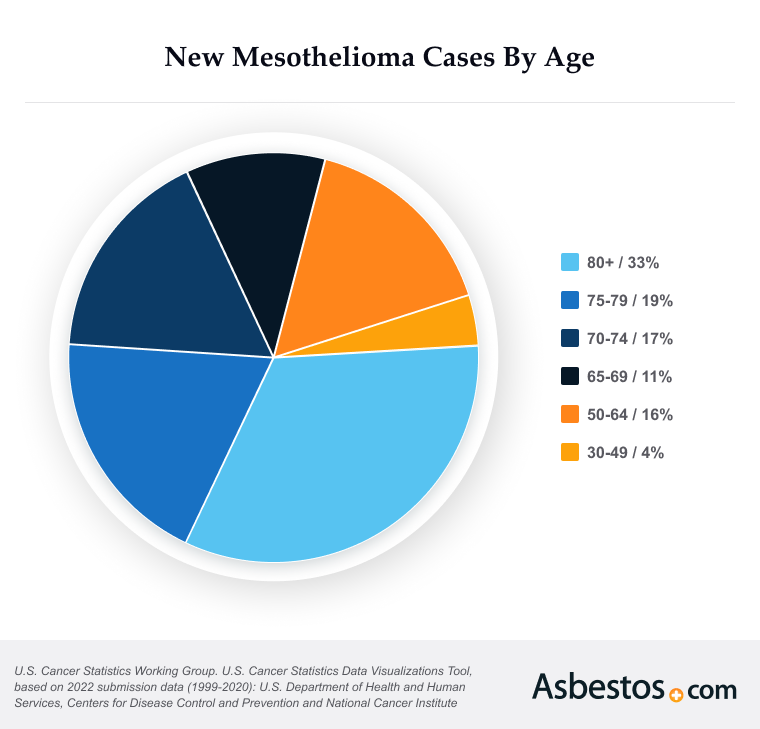
Mesothelioma Survival Rates by Age
Younger patients have significantly higher mesothelioma survival rates than older patients. More than 50% of patients diagnosed before the age of 50 survive 1 year, while fewer than 33% of those 75 or older survive the same length of time.
There were 502 mesothelioma deaths among patients ages 85 and older in 2022, the latest year for which data on mortality by age is available. That same year, 21 people between the ages of 45 and 49 died of mesothelioma.
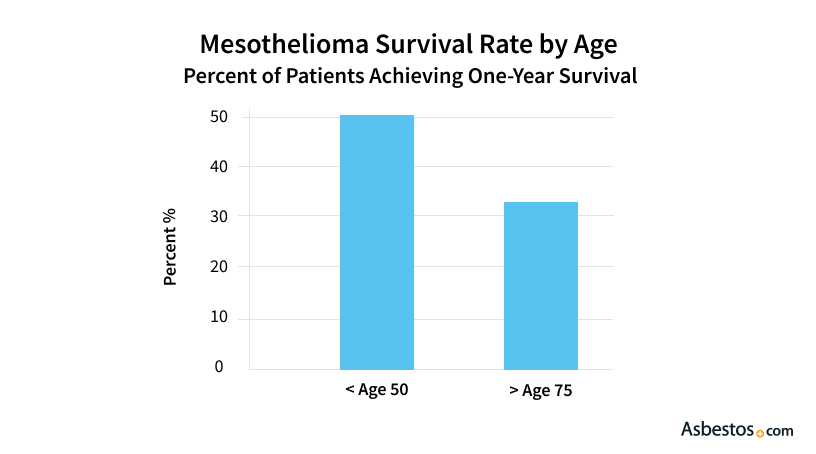
Mesothelioma Incidence by Gender
Historically, mesothelioma has been primarily diagnosed in men. According to the CDC’s United States Cancer Statistics, men made up 70% and women 30% of new mesothelioma cases in the U.S. in 2021. There were 1,973 new mesothelioma cases among men and 830 in women.
Women at the highest risk of developing mesothelioma from asbestos exposure are registered nurses, homemakers and teachers in elementary and middle school. A recent study found among people older than 44 years, mesothelioma incidence rates were higher among men. Among those younger than 45 years, women had higher incidence rates.
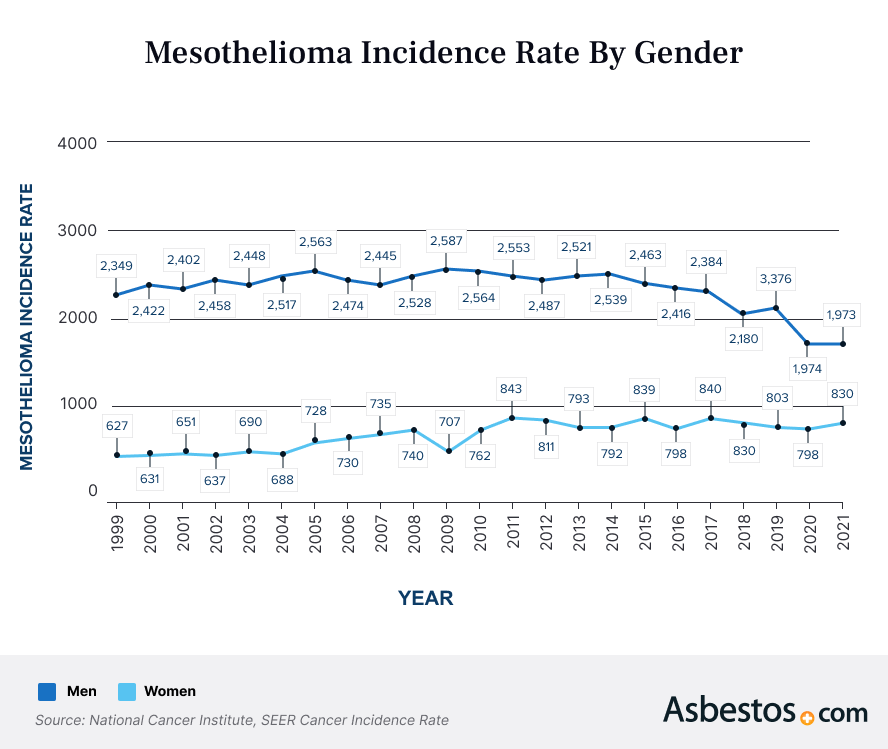
Mesothelioma Latency Period by Gender
The time from the initial asbestos exposure to when symptoms appear, or latency period, tends to be longer for women than for men. It’s believed this is because a significant percentage of women experienced secondhand exposure over time rather than primary exposure.
Men’s higher rates of heavy occupational asbestos exposure likely result in a shorter latency period. The latency period for men is about 48 years. The latency period for women is about 53 years.
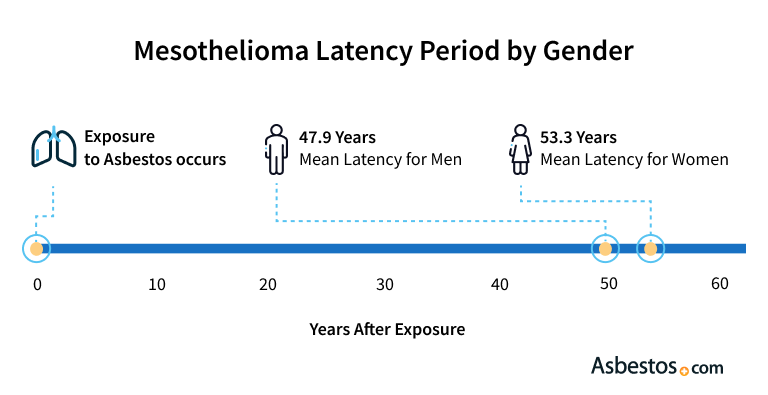
Mesothelioma Survival Rates by Gender
Women tend to have better survival rates than men. For example, the 5-year survival rate for women with pleural mesothelioma is about 16%. For men, it’s around 7%.
However, according to the CDC, mesothelioma deaths among women increased significantly. Mesothelioma cancer deaths for women increased 25% from 1999 to 2020. Combining statistics for both men and women, there were 2,376 mesothelioma deaths in 2020.
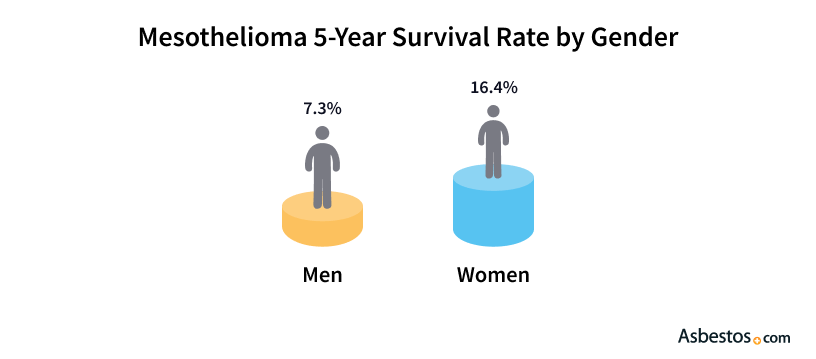
Mesothelioma Statistics by Race or Ethnicity
Most mesothelioma patients are non-Hispanic white, with 81% of cases in 2021. According to CDC data from 2017 to 2021, a total of 12,174 new mesothelioma cases were diagnosed in white individuals. This is in stark contrast to only 1,275 cases in Hispanic individuals and 741 new cases in non-Hispanic Black individuals.
SEER data shows a decline in mesothelioma incidence rates for non-Hispanic white individuals, from 1.3 to 0.8 cases per 100,000 people from 2000 to 2021. Incidence rates have remained fairly steady for Hispanic, non-Hispanic Black and non-Hispanic Asian/Pacific Islander populations.
The 5-year survival rate also appears to vary between races. The most recent year for compiled data by race is 2015 when the reported 5-year survival rate was about 19% for Black people and 9% for those who were white.
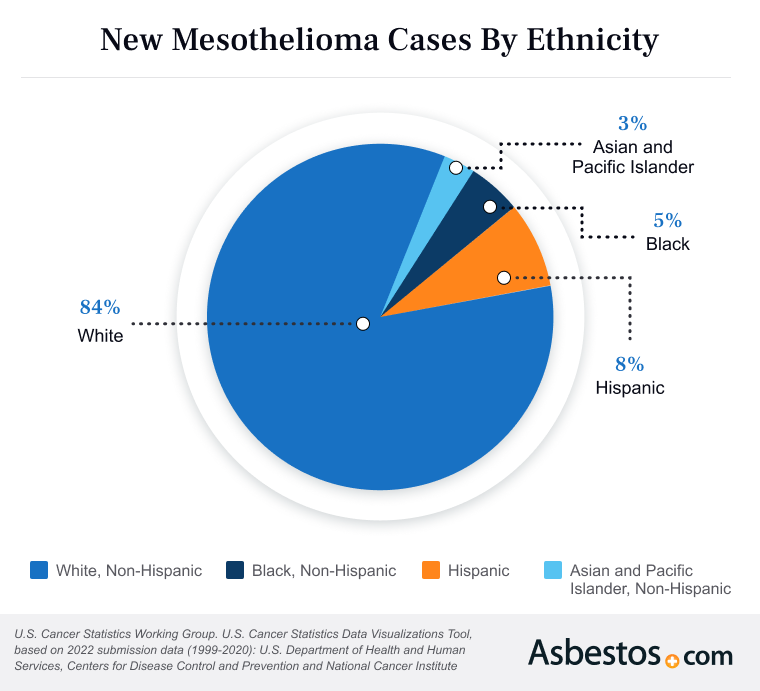
Mesothelioma Costs and Financial Statistics
National Cancer Institute statistics estimate the cost of lung cancer treatment to be more than $60,000 for the first year. Mesothelioma treatment costs are comparable. Expenses can include medical bills, lost wages and travel costs.
Some people qualify for financial aid, such as VA benefits and Social Security Disability Insurance. Patients can also file legal claims to help cover costs. These include asbestos trust fund claims and mesothelioma lawsuits.
Mesothelioma Claims and Financial Compensation
- People filed 1,907 mesothelioma lawsuits in 2024, according to KCIC’s Asbestos Litigation: 2024 Year in Review.
- The average mesothelioma settlement is $1 million to $2 million.
- The average trial verdict amount is $20.7 million, according to the 2024 Mealey’s Litigation Report.
- There are more than 60 active asbestos trusts with funds for future asbestos claims.
- Asbestos trust funds paid claimants nearly $24 billion between 2004-2016.
As Patient Advocate and VA-accredited claims agent Danielle DiPietro notes, “It’s important for patients and families to seek out financial assistance. You really can’t expect what a diagnosis is going to cost for treatment or at-home care, or what your family’s needs are. So it’s always important to plan for the future.”

